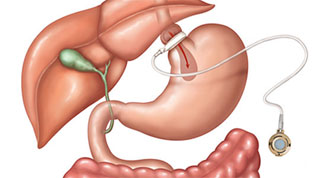Gastric Band
Request an Appointment for Bariatric Gastric Band
What Is Gastric Band?
Gastric banding surgery is a bariatric procedure that is often performed through several small incisions (laparoscopically). It is a purely restrictive weight loss surgery. This means that gastric-band surgery works by reducing the size of the stomach, making the patient feel full from less food. Gastric-band surgery is less complex than other bariatric surgery options. It is also reversible, unlike some other weight loss procedures.

During this procedure, the surgeon inserts a silicone band around the upper portion of the stomach, creating a small pouch. The band is lined with an inflatable balloon that can be filled with saline to change the size of the opening at the bottom of the small pouch. Next, the surgeon implants an injection port that is connected to the gastric band balloon by a tube. Saline can be injected into the band through this port to tighten it and increase weight loss. Fluid can also be removed in order to loosen the band, decreasing weight loss.
The smaller stomach pouch fills with food quickly, helping the patient feel satisfied with less food. The band can be removed, although it is designed to remain permanently.
Advantages of Gastric Band Surgery
- Weight loss happens as a result of eating less food
- There are lower risks for nutritional deficiencies
- No “dumping” syndrome
- The band becomes an “implantable” device and remains in the body
- The band can be adjusted to increase or decrease restriction
- Digestion is normal
- It is reversible
Disadvantages of Gastric Band Surgery
- Gastric perforation or tearing of the stomach during the surgical procedure
- Access port may leak or twist
- May not provide the feeling of feeling “full”
- Nausea or vomiting
- Outlet obstruction
- Pouch dilatation
- Band migration or slippage



